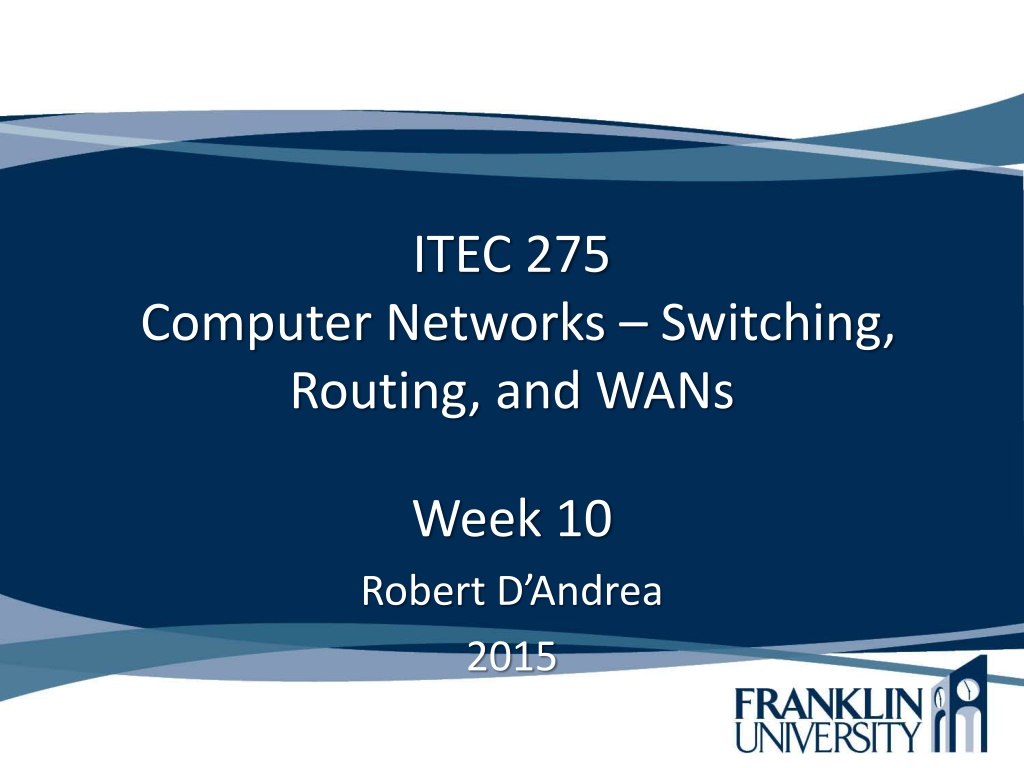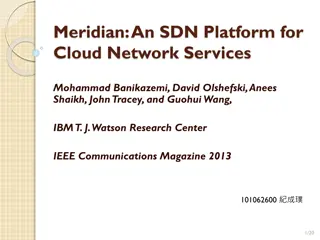
Exploring WAN Technologies in Computer Networks
Dive into the world of WAN technologies such as PPP, Cable Modems, DSL, SONET, Frame Relay, Metro Ethernet, and ATM. Learn about selecting WAN service providers, enterprise devices, and remote access technologies. Understand the criteria for choosing the right technology based on business requirements and constraints. Discover the versatility and security features of Point-to-Point Protocol (PPP) for connecting remote users and offices to central locations.
Download Presentation

Please find below an Image/Link to download the presentation.
The content on the website is provided AS IS for your information and personal use only. It may not be sold, licensed, or shared on other websites without obtaining consent from the author. If you encounter any issues during the download, it is possible that the publisher has removed the file from their server.
You are allowed to download the files provided on this website for personal or commercial use, subject to the condition that they are used lawfully. All files are the property of their respective owners.
The content on the website is provided AS IS for your information and personal use only. It may not be sold, licensed, or shared on other websites without obtaining consent from the author.
E N D
Presentation Transcript
ITEC 275 Computer Networks Switching, Routing, and WANs Week 10 Robert D Andrea 2015
Agenda Learning Activities PPP Cable Modems and DSL Leased Lines, SONET, Frame Relay, Metro Ethernet, ATM Selecting a WAN Service Provider Metro Ethernet
Enterprise Technologies and Devices Remote access networks Wide area networks (WANs) Devices End user remote access devices Central site remote access devices VPN concentrators Routers
Selection Criteria Business requirements and constraints Cost Technical goals Bandwidth requirements QoS requirements Network topology Traffic flow and load
Remote Access Technologies The Point-to-Point Protocol (PPP) Integrated Services Digital Network (ISDN) Cable modems Digital Subscriber Line (DSL)
Point-to-Point Protocol (PPP) PPP is used with synchronous, asynchronous, dial-up, and ISDN links Defines an encapsulation scheme for transport of different network-layer protocols Supports authentication: Password Authentication Protocol (PAP) Challenge Handshake Authentication Protocol (CHAP). CHAP more secure than PAP
Point-to-Point Protocol (PPP) The Internet Engineering Task Force (IETF) developed PPP as a standard data link layer protocol for transporting various protocols across serial, point-to-point links. PPP can be used to create point-to-point links between different vendor s equipment. PPP uses a Network Control Protocol field in the Data Link header to identify the Network layer protocol.
Point-to-Point Protocol (PPP) PPP can be used to connect a single remote user to a central office, or to connect a remote office with many users to a central office. PPP is a data-link protocol that can be used over either asynchronous serial (dial-up) or synchronous serial (ISDN) media and that uses the LCP (Link Control Protocol) to build and maintain data-link connections.
PPP Layers Network Control Protocol (NCP) Link Control Protocol (LCP) Encapsulation based on High-Level Data-Link Control Protocol (HDLC) Physical Layer
PPP Point-to-Point (PPP) is a data link protocol commonly used in establishing a direct connection between two networking nodes. It provides connection authentication, transmission authentication, and compression. PPP is used over many types of physical networks including serial cable, phone line, trunk line, cellular telephone, and fiber optic links such as SONET. PPP is also used over the Internet access connections (broadband).
PPP Leased Line PPP, HDLC Frame Relay, X.25, ATM Packet Switching Circuit Switching PPP, HDLC
PPP Metro Ethernet Ethernet PPPoE, PPPoA, Ethernet Broadband
PPP Leased lines: ISP is the service provider. PPP protocol. The user does not want to share the wire or the expense of leasing a wire with another user. Packet Switching: Telco is the service provider. Frame Relay protocol. The user shares the service with other users to save money. Frame Relay is an alternate technology to PPP. Circuit Switching: Pots or ISDN are the service providers. PPP protocol. Data is sent encapsulated over the public telephone network system.
PPP Metro Ethernet: Telco is the service provider. Ethernet protocol. The user wants the data sent at a very high speed. Broadband: Telco is the service provider. PPPoE, PPPoA, Ethernet protocols.
PPP PPP encapsulation includes: 1. Line set up using LCP. The link is established during this phase. 2. Authentication, encryption and compression (optional). 2.1 Password Authentication Protocol (PAP) Avoid using PAP because it sends the password in ASCII format (clear text). 2.2 Challenge Handshake Authentication Protocol (CHAP) never sends the password, but sends a challenged handshake processes.
PPP 3. PPP carries packets from many different protocol suites using NCP. The NCP sends packets to negotiate the needed settings. Is all data encrypted? No Encryption is used to simply verify the passwords.
Multilink MPPP An ordinary dial-up modem connection to the Internet through an Internet service provider (ISP) usually uses PPP as its wide area network (WAN) data- link protocol, but there are times when the 56-Kbps speed provided by V.90 modems is insufficient. MPPP allows multiple physical dial-up links to be inverse multiplexed together to form a single high-bandwidth logical PPP connection between the dial-up client and the ISP. MPPP works by ordering the data frames from the client across the multiple PPP channels and recombining them at the ISP s termination point, and vice versa.
Multilink MPPP MPPP defines protocols for splitting the data stream into PPP packets, sequencing the packets, transmitting them over separate logical data links, and then recombining them at the receiving station.
Multilink MPPP Inverse multiplexing speeds up data transmission by dividing a data stream into multiple concurrent streams that are transmitted at the same time across separate channels (such as a T-1 or E-1 lines) and are then reconstructed at the other end back into the original data stream. Just the reverse of ordinary multiplexing , which combines multiple signals into a single signal, inverse multiplexing is a technique commonly used where data in a high-speed local area network (LAN) flows back and forth into a wide area network (WAN) across the "bottleneck" of a slower line such as a T-1 (1.544 Mbps).
Multilink MPPP Various multiplexing methods are possible in terms of the channel bandwidth and time, and the signal, in particular the frequency, phase or time. The two basic methods are: Frequency Division Multiplexing (FDM) is derived from AM techniques in which the signals occupy the same physical line but in different frequency bands. Each signal occupies its own specific band of frequencies all the time, i.e. the messages share the channel bandwidth.
Multilink MPPP Time Division Multiplexing (TDM ) is derived from sampling techniques in which messages occupy all the channel bandwidth but for short time intervals of time, i.e. the messages share the channel time.
Multilink MPPP Adds support for channel aggregation fo PPP. Channel aggregation can be used for load sharing and providing extra bandwidth. With channel aggregation, a device can automatically bring up additional channels as bandwidth requirements increase. MPPP ensures that packets arrive in order at the receiving device.
Multi-chassis MPPP Cisco s enhancement to PPP is MPPP. MPPP allows WAN administrator to group multiple access servers into a single stack group. The user s traffic can be split and reassembled across multiple access servers in the stack group.
Multi-chassis Multilink PPP Stack group ISDN Offload server Analog
CHAP CHAP provides a three-way hand-shake. Provides protection by verifying a remote node with a three-way hand shake and a variable challenge value that is unique and unpredictable.
CHAP Remote Node Access Server Connect Database of Users and Passwords Challenge Name: 760_1 Password: sfy45 Name: 760_1 Password: sfy45 Hashed Response Name: 760_2 Password: kingsford Accept or Deny
ISDN Digital data-transport service offered by regional telephone carriers (Telcos). Circuit-switched service that carries voice and data. ISDN is a set of digital services that transmits voice and data over existing phone lines. Cost-effective remote-access solution for telecommuters and remote offices Cost of an ISDN circuit is usually based on a monthly fee plus usage time Good choice as a backup link for another type of link, for example, Frame Relay. Channel aggregation is popular with ISDN links.
ISDN Interfaces Basic Rate Interface (BRI) } 64 Kbps 64 Kbps 2B 144 Kbps D 16 Kbps Primary Rate Interface (PRI) 1.544 Mbps in U.S. 64 Kbps 64 Kbps} 23B or 30B 2.048 Mbps in Europe D
ISDN Components R S/T U Non-ISDN device (TE2) To ISDN service NT1 TA 4-wire circuit 2-wire circuit S/T U ISDN device (TE1) To ISDN service NT1 S T U ISDN device (TE1) To ISDN service NT1 NT2 U ISDN device (TE1) with built-in NT1 To ISDN service NT1
Cable TV Service CATV (originally "community antenna television," now often "community access television") is more commonly known as "cable TV." Television programs were brought to millions of people throughout the world who were connected to a community antenna, cable TV. Today, CATV has become an increasingly popular way to interact with the World Wide Web and other new forms of multimedia information and entertainment services.
Cable TV Service Operates over the coax cable used by cable TV providers Much faster than analog modems, and usually much faster than ISDN (depending on how many users share the cable) 25 to 50 Mbps downstream from the head end 2 to 3 Mbps upstream from end users Standard = Data Over Cable Service Interface Specification (DOCSIS)
Cable TV Service Coax Cable does not require dial-up. Cable modem operates more like a LAN. Cable-network providers offer hybrid fiber/coax (HFC) systems that connect CATV networks to the service provider s high-speed fiber-optic network. HFC systems allow connections of home PCs and small LANs to high-speed access to the Internet or to a private network using VPN.
Cable TV Service CATV (Cable Modem Termination System) provides high-speed connectivity for cable modems. Cable modem solution for remote users or remote offices is the sharing a single cable and the types of applications they use.
DSL High-speed digital data traffic over ordinary telephone wires. Sophisticated modulation schemes mean higher speeds than ISDN. Speeds range from 1.544 to 9 Mbps Actual bandwidth depends on type of DSL service, DSL modem, and many physical-layer factors. Symmetric communication (SDSL) traffic flow travels at the same speed up to 1.544 Mbps. Asymmetric DSL (ADSL) very popular Downstream faster than upstream
PPP and ADSL Asymmetric DSL (ADSL) uses two popular PPP implementations. 1. PPP and ATM (PPPoA) the CPE acts as an Ethernet-to-WAN router and the PPP session is established between the CPE and Layer 3 access concentrator in the service provider s network. 2. PPP and Ethernet (PPPoE) the CPE acts as an Ethernet-to-WAN bridge.
PPP and ADSL PPP and Ethernet (PPPoE) the CPE acts as an Ethernet-to-WAN bridge. The client initiates a PPP session by encapsulating PPP frames in MAC frames and then bridging the frames over ATM/DSL to a gateway router at the service provider. From that point, the PPP session can be established, authenticated, and achieved. The client receives its IP address from the service provider, using PPP negotiation.
Provisioning WAN Bandwidth A critical network design is considering capacity requirements. Selecting the right amount of capacity for current and future needs. Provisioning requires an analysis of traffic flows, and analysis of scalability goals.
WAN Technologies Leased lines Synchronous Optical Network (SONET) Frame Relay Asynchronous Transfer Mode (ATM)
Leased Lines Dedicated digital, copper circuits that a customer leases from a carrier for a predetermined amount of time, usually for months or years. Speeds range from 64 Kbps to 45 Mbps. Enterprises use leased lines for both voice and data traffic.
Leased Lines Dedicated connection or Point-to-Point connection. Pre-established WAN communications path from the Customer Premise Equipment (CPE) , through the Data Communications Equipment (DCE) switch, to the CPE of the remote site, then allowing Data Terminal Equipment (DTE) networks to communicate at anytime with no set up procedure before transmitting data.
DTE and DCE The end instrument is a piece of equipment connected to the wires at the end of a telecommunication link. End instruments that relate to data terminal equipment (DTE) include printers, computers, barcode readers, automated teller machines (ATMs) and the console ports of routers.
DTE and DCE The data communication(s) equipment (DCE) is a device that sits between the DTE and a data transmission circuit. The DCE performs functions such as signal conversion, line clocking, and coding. The DTE/DCE classification was introduced by IBM.
Digital Signal (DS) A channel in the NADH (North American Digital Hierarchy) is called a digital signal (DS). Digital signals are multiplexed together to form high-speed WAN circuits. DS-1 and DS-3 are the most commonly used capacities.
The North American Digital Hierarchy
Synchronous Optical Network (SONET) Synchronous Optical Network (SONET) is the American National Standards Institute standard for synchronous data transmission on optical SDH (Synchronous Digital Hierarchy) is a standard technology for synchronous data transmission on optical media.
Synchronous Optical Network (SONET) Physical-layer specification for high-speed synchronous transmission of packets or cells over fiber-optic cabling. Service providers and carriers make wide use of SONET in their internal networks. Gaining popularity within private networks.
Synchronous Optical Network (SONET) Goals of SONET and SDH 1. Define higher speeds than the ones used by the NADH. 2. Support efficient multiplexing and de-multiplexing of individual signals. With SONET, it is easy to isolate one channel from a multiplexed circuit. With plesiochronous systems, like NADH and European E system, isolating one channel is more difficult.
Synchronous Optical Network (SONET) Plesiochronous (pronounced plee-see-AH- krun-us, from Greek plesos, meaning close, and chronos, meaning time) is an adjective that describes operations that are almost, but not quite, in synchronization - in other words, almost synchronous.
Synchronous Optical Network (SONET) Terminating multiplexers (implemented in switches and routers) provide user access to the SONET network. Terminating multiplexers convert electrical interfaces into optical signals and multiplex multiple payloads into STS-N signals required for optical transport.






















